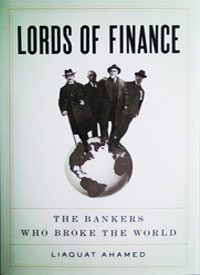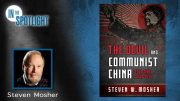
Until now. Historians as a rule are loath to write about economics; having little grasp of monetary theory, banking, trade, and other matters economic, they typically focus instead on politics and war. But Liaquat Ahamed, a banker and investor by training who happens to have a flair for historical narrative, has produced a tome, Lords of Finance: The Bankers Who Broke the World, on early 20th-century history that is must reading for anyone desiring to truly understand the roots of the great economic crisis now roiling the world.
Ahamed, we hasten to add, is by no means an adherent of the Austrian (free market) school of economics. A former World Bank employee with a Harvard and Cambridge pedigree as an economist, Ahamed is an unabashed Keynesian (socialist) economist, well-connected enough to list Strobe Talbott as an adviser for the writing of his book.
But discounting Ahamed’s biases, Lords of Finance is an elegantly written work of history-cum-biography, a narrative of the financial history of World War I through the early thirties interwoven with intimate and meticulously researched life stories of the world’s four most important central bankers of that era. These four men — Benjamin Strong, head of the New York Federal Reserve; Montagu (“Monty”) Norman, governor of the Bank of England; Émile Moreau of the Banque de France; and Hjalmar Schacht of the Reichsbank — quietly helped to engineer the post-World War I economic boom in the 1920s, and then (except for Strong, who died in 1928) presided over the utter ruin of the early thirties.
Budding Bankers
The pre-World War I world was the heyday of the gold standard, when all of the world’s major currencies — and the central bankers who tried to manipulate them — were fettered by ties to gold. Inflation in the modern sense did not exist because central banks were bound by law to redeem obligations in gold if called upon to do so. The Banque de France was particularly careful to keep large reserves of gold to back the franc; and the English pound sterling, the coin of the world-encircling British Empire, was the world’s reserve currency, the Bank of England enjoying an unparalleled reputation for honoring its promises to redeem in specie. Central bankers of the age were, then as now, a close-knit group, but most of them, including the four protagonists of Lords of Finance, believed in the gold standard.
On the eve of World War I, only Benjamin Strong had achieved any great professional reputation. The precocious Strong had been a protégé of J.P. Morgan and his associate, Henry Davison, for several years. He had been tapped to participate (along with Davison, European banking expert Paul Warburg, Rhode Island Senator Nelson Aldrich, and several other titans of finance) in a secret meeting held at Jekyll Island, Georgia, in 1909 to draft a plan for an American central bank. When the bank, misleadingly named the Federal Reserve, was created by an act of Congress in 1913, Strong became the head of the New York Federal Reserve. For the first couple decades of the Fed’s existence, the head of the New York Fed, because of proximity to America’s financial and banking nerve center, exercised far more power than the Federal Reserve Chairman or its Board of Governors. The energetic Strong was, for the remainder of his life, America’s de facto central banker.
Strong’s counterpart across the Atlantic Ocean, Montagu Norman, came of age during the war, when he unexpectedly ascended to the governorship of the Bank of England after years of very modest attainments. He had served with distinction in the Boer War, but after that brush with excitement seemed destined to live out his life as a colorless financial functionary. He did not marry until very late in life, and after assuming the governorship of his nation’s central bank often said that the Bank of England was his only mistress.
During the war, Strong and Norman formed an unlikely friendship, which lasted until Strong’s death and was, perhaps more than any other single factor, responsible for the havoc wrought on world finances after the war.
The world war, unexampled in scope, forced all of its participants except the United States to go off the gold standard. Central banks suspended specie payments and fired up the printing presses to finance the war effort. When at last the war ended, money supplies in every country had increased drastically, meaning that a realistic return to the prewar gold standard would have involved a significant discount in buying power of each nation’s currency.
But England insisted on restoring the gold standard at the prewar par, and Norman and the Bank of England on continuing to inflate the pound to avoid the pain of currency devaluation. The problem was that, unless other central banks, especially the Federal Reserve, agreed to inflate in tandem with the Bank of England, the pound would lose value relative to other currencies (especially the comparatively strongly backed U.S. dollar), and Britain’s reserves of precious metals would flow overseas.
Fortunately for Britain, at least in the short term, Montagu Norman, thanks to his friendship with Benjamin Strong, had little trouble persuading the latter to follow Britain’s lead in monetary policy in an attempt to preserve the financial status quo. The relationship between the two men is one of the odder episodes in the annals of economic history; they corresponded frequently and on a deeply personal basis, as material quoted by Ahamed from their voluminous correspondence clearly attests. Norman was fond of crossing the Atlantic incognito during those years to spend time with Strong, and Strong began vacationing in the south of France with Norman.
Toward the end of his life, Strong had a bitter falling out with his friend and, although the two patched things up by correspondence, never saw each other again. Norman was devastated by Strong’s death in 1928, an event that betokened the end of his influence as master of the world’s most important currency.
The other two central bankers in Ahamed’s narrative, Moreau and Schacht, found themselves marginalized by the Strong-Norman relationship and by the tenuous state of financial affairs on the European continent. Schacht came to ascendancy after the disastrous German hyperinflation of the early twenties, which wiped out German savings as well as punitive war reparations to be paid in marks. Schacht’s role as Germany’s central banker thus became one of seeking to negotiate Germany’s way out of postwar financial obligations imposed by the victorious and vindictive Allies.
The Frenchman Moreau appears to have been the most level-headed of the four, understanding better than the rest what the reckless inflationary policies of his colleagues would ultimately lead to. Although all four men professed allegiance to the gold standard (and repugnance for the views of economist John Maynard Keynes, whose anti-gold, pro-inflation program was just beginning to receive a hearing), it was Moreau who perceived that giving inflationary cover to the weakened pound would mean disaster in the long run.
Going Against Gold
But Ahamed, who, with Keynes, sees the gold standard as a “barbarous relic,” commits a critical error in equating the postwar “gold standard” with what had gone before. For what the great powers (except for the United States) instituted in the wake of the war was not a gold standard but a gold exchange standard. Gold coins no longer circulated as currency after the war, and redemption in specie was available only to international investors — similar to circumstances in the United States from the end of World War II to 1971. A gold exchange standard meant that the British government was no longer beholden to its own citizens, but only to an exclusive club of international bankers and financiers, in conducting its monetary policy. For the latter, in fact, inflationary activity was typically beneficial, since it meant (as it does in our day) rapidly expanding asset portfolios and easy credit.
The faux “gold standard” that the young Keynes was so fond of attacking was thus a convenient straw man, and its collapse in the early 1930s, which Keynes had predicted, tended to give credence to a man who, in more lucid times, would have been correctly dismissed as a quack.
After the death of Benjamin Strong, leadership of the Federal Reserve passed to the new head of the New York Fed, George L. Harrison, a lawyer with “impeccable establishment credentials,” according to Ahamed. Harrison was a member of the ultra-elite Yale secret society Skull and Bones and had served a clerkship with Supreme Court Justice Oliver Wendell Holmes. A Benjamin Strong protégé who had worked with both Norman and Moreau, Harrison lacked the forceful personality of his predecessor.
In the post-Strong British-American financial dynamic, the Fed and the Bank of England found coordination of policies more difficult, and the entire house of cards, erected on the inflationary bubble of the Roaring Twenties, fell apart.
First came the puncturing of the stock bubble in late 1929, which wiped out fortunes across the Western world. (In what might be regarded as a slender thread of historical justice, France, whose conservative central banker Moreau had been cautious of the inflationary policies of his colleagues from the get-go, was the least affected by the ravages of the stock market collapse and the depression that was to follow.) Soaring unemployment followed and, in the early 1930s, the collapse of currencies, including, at last, the pound sterling.
The following two years were the deepest of the Depression, and saw even the French and Americans finally go off the gold standard. It was a time of bursting bubbles, and not only economic. Many of the men who had made fortunes in the Roaring Twenties were now exposed as hucksters by the relentless economic contraction. Ivar Kreuger, the celebrated Swedish financier and international bon vivant, committed suicide in his Paris apartment as the shell game that his financial empire had become came unraveled. Investors lost some $400 million from that debacle.
Others fared better. Albert Wiggins, president of Chase Bank, had sold his bank stock short during the bubble and pocketed a huge profit when stocks collapsed. Banking titans, like National City Bank’s Charles Mitchell — nicknamed “Sunshine Charlie” — as well as J. P. Morgan himself, had managed to avoid paying federal income taxes thanks to various financial sleights of hand available to the ultra-rich and well-connected.
The media of the day fulminated against the financial-powers-that-be to little effect. “If you steal $25,000 you’re an embezzler. If you steal $2,500,000, you’re a financier,” sputtered the Nation, a popular magazine. Father Charles Coughlin, a Michigan pastor who is considered the originator of right-wing talk radio, touched a raw nerve excoriating the “banksters,” as he called them. But with a shallow understanding that has become a hallmark of most talk-radio entertainers, he also blasted the gold standard which “from time immemorial has been the breeder of hate, the fashioner of swords, and the destroyer of mankind” — even as he urged his listeners to rise up “against the Morgans, the Kuhn-Loebs, the Rothschilds, the Dillon-Reeds, [and] the Federal Reserve banksters.”
Such contradictory understanding has always been typical of the financial havoc wrought by central bankers and their arcane activities, especially in the age of unfettered inflation in which we now live. The four central bankers of Ahamed’s history were well known in their day, but their role in world affairs was little understood, even by politicians who gave countenance to their activities. Like high priests of some mysterious religion, their activities were and are regarded with numinous awe, and their pronouncements assumed to be infallible. When that proved not to be the case, the public, already fleeced and impoverished by the “banksters,” could do little but sputter and shuffle off to the unemployment lines. In the case of Hjalmar Schacht’s Germany, the fallout was rather worse: the political and financial collapse of the Weimar Republic gave Hitler’s Nazis an opportunity to seize power.
Today, as in the 1930s, the citizenries of the world’s wealthiest nations are again being taken to the cleaners by celebrity bankers and financiers known by name in most households, but whose secret wizardry is comprehended by very few. Liaquat Ahamed’s book, though deficient in its appreciation of the fallacies of Keynesian economics, is one of the best histories of the secretive world of international banking and the men and events that brought about the financial and economic age in which we still live.
Lords of Finance: The Bankers Who Broke the World, by Liaquat Ahamed, New York: Penguin Group, 2009, 564 pages, hardcover, $32.95.



